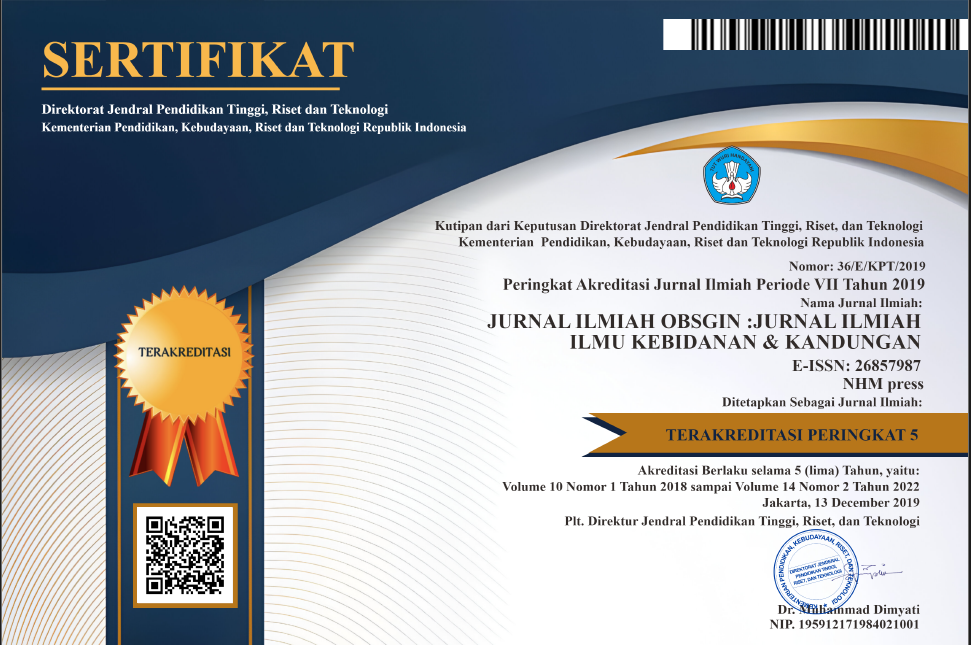POLA DIET ANAK, SEBERAPA BESAR HUBUNGANNYA DENGAN STUNTING DI INDONESIA ?
Abstract
Indonesia is currently ranked fifth in the highest number of stunting cases in the world. Malnutrition is still one of the causes of the high stunting rate in Indonesia. This study aims to examine studies on stunting that have been carried out in Indonesia systematically.
Five online databases, including Google Scholar, PubMed, Wiley Online Library, Proquest, and Science Direct, were searched to identify relevant studies. The search is performed on the Title and Abstract. The combination of keywords and Medical Subject Headings (MeSH) used: Dietary, Food pattern, Nutrition, Stunting, Children, under five, Indonesia.
The entire study was conducted in several regions in Indonesia including East Java, Malang, Lamongan, Bogor, Yogyakarta, and Madura. The submitted studies are published in reputable international journals and in English. The included study design consisted of 3 cross-sectional, and 2 case-control. The age of stunted children involved in the six studies reviewed was 6 – 59 months.
The diet of children with stunting as a whole does not show conformity with the standard of nutritional needs to support the growth of children. From the five studies studied, it can be seen that the consumption patterns of children in Indonesia are less varied, low in vitamin D intake, low in calcium, and phosphorus.
References
Alifariki, L.O, Kusnan, A., Binekada, I. M. C., & Usman, A. N. (2020). The proxy determinant of complementary feeding of the breastfed child delivery in less than 6 months old infant in the fishing community of Buton tribe. Enfermeria Clinica, 30, 544–547.
Alifariki L, Rangki, L., Haryati, H., Rahmawati, R., Sukurni, S., & Salma, W. O. (2020). Risk Factors of Stunting in Children Age 24-59 Months Old. Media Keperawatan Indonesia, 3(1), 10–16.
Alifariki, L. O. (2020). Gizi Anak dan Stunting. Yogyakarta. Penerbit LeutikaPrio.
Alpin, A. (2021). Hubungan Karakteristik Ibu dengan Status Gizi Buruk Balita di Wilayah Kerja Puskesmas Tawanga Kabupaten Konawe. Nursing Care and Health Technology Journal (NCHAT), 1(2), 87–93.
Checkley, W., Buckley, G., Gilman, R. H., Assis, A. M. O., Guerrant, R. L., Morris, S. S., Mølbak, K., Valentiner-Branth, P., Lanata, C. F., & Black, R. E. (2008). Multi-country analysis of the effects of diarrhoea on childhood stunting. International Journal of Epidemiology, 37(4), 816–830.
Choi, S.-W. (2020). Growth and nutritional status of children in North Korean refugee families. Journal of The Korean Society of Maternal and Child Health, 24(2), 96–101.
Crowe, F. L., Mughal, M. Z., Maroof, Z., Berry, J., Kaleem, M., Abburu, S., Walraven, G., Masher, M. I., Chandramohan, D., & Manaseki-Holland, S. (2021). Vitamin D for growth and rickets in stunted children: A randomized trial. Pediatrics, 147(1).
Esposito, S., Leonardi, A., Lanciotti, L., Cofini, M., Muzi, G., & Penta, L. (2019). Vitamin D and growth hormone in children: a review of the current scientific knowledge. Journal of Translational Medicine, 17(1), 1–18.
Farías-Antúnez, S., Xavier, M. O., & Santos, I. S. (2018). Effect of maternal postpartum depression on offspring’s growth. Journal of Affective Disorders, 228, 143–152. https://doi.org/10.1016/j.jad.2017.12.013
Fatmawati, Y. D., Rosyadah, R., Damayanti, M. D., Abigael, D. P., Ismawati, F., Ilmi, A. F., & Ratnaningtyas, T. O. (2020). Kuliah Whatsapp Dalam Meningkatkan Pengetahuan Ibu Terhadap Pencegahan Stunting Pada Balita Di Masa Pandemi. Jam: Jurnal Abdi Masyarakat, 1(1).
Faye, C. M., Fonn, S., Levin, J., & Kimani-Murage, E. (2019). Analysing child linear growth trajectories among under-5 children in two Nairobi informal settlements. Public Health Nutrition, 22(11), 2001–2011.
Kemenkes RI. (2018). Hasil utama RISKESDAS 2018. In Kementerian Kesehatan Badan Penelitian dan Pengembangan Kesehatan. https://kesmas.kemkes.go.id/assets/upload/dir_519d41d8cd98f00/files/Hasil-riskesdas-2018_1274.pdf
Krasevec, J., An, X., Kumapley, R., Bégin, F., & Frongillo, E. A. (2017). Diet quality and risk of stunting among infants and young children in low‐and middle‐income countries. Maternal & Child Nutrition, 13, e12430.
La Aga, Erwin, A. L. . (2019). Cakupan dan Determinan Pemberian ASI Ekslusif di Pemukiman Kumuh Dalam Perkotaan di Kecamatan Tallo Kota Makassar. Majalah Kesehatan FKUB, 6(1), 44–55.
Lestari, R. I., Dwi Sarbini, S. S. T., Rakhma, L. R., Gz, S., & Gizi, M. (2016). Faktor Risiko Kejadian Stunted Pada Anak Usia 7-24 Bulan Di Desa Hargarejo, Kecamatan Kokap, Kabupaten Kulon Progo, Yogyakarta. Universitas Muhammadiyah Surakarta.
Lestari, W., Margawati, A., & Rahfiludin, Z. (2014). Faktor risiko stunting pada anak umur 6-24 bulan di kecamatan Penanggalan kota Subulussalam provinsi Aceh. Jurnal Gizi Indonesia (The Indonesian Journal of Nutrition). https://doi.org/10.14710/jgi.3.1.126-134
Li, Z., Kim, R., Vollmer, S., & Subramanian, S. V. (2020). Factors associated with child stunting, wasting, and underweight in 35 low-and middle-income countries. JAMA Network Open, 3(4), e203386–e203386.
Mahmudiono, T., Sumarmi, S., & Rosenkranz, R. R. (2017). Household dietary diversity and child stunting in East Java, Indonesia. Asia Pacific Journal of Clinical Nutrition, 26(2), 317–325.
Maulidiana, A. R., & Sutjiati, E. (2021). Low intake of essential amino acids and other risk factors of stunting among under-five children in Malang City, East Java, Indonesia. Journal of Public Health Research, 10(2).
Min, W., Nie, W., Song, S., Wang, N., Nie, W., Peng, L., Liu, Z., Nie, J., Yang, J., Ma, Y., & Shi, Y. (2020). Associations between Maternal and Infant Illness and the Risk of Postpartum Depression in Rural China: A Cross-Sectional Observational Study. International Journal of Environmental Research and Public Health, 17(24), 9489. https://doi.org/10.3390/ijerph17249489
Muslimatun, S., & Wiradnyani, L. A. A. (2016). Dietary diversity, animal source food consumption and linear growth among children aged 1–5 years in Bandung, Indonesia: A longitudinal observational study. British Journal of Nutrition, 116(S1), S27–S35.
Nurhayati, N., Asmawati, A., Ihromi, S., Marianah, M., & Saputrayadi, A. (2020). Penyuluhan Gizi dan Pelatihan Pengolahan Produk Berbasis Jagung Sebagai Upaya Meminimalisir Stunting di Desa Labuapi Kabupaten Lombok Barat. JMM (Jurnal Masyarakat Mandiri), 4(5), 806–817.
Paramashanti, B. A., Paratmanitya, Y., & Marsiswati, M. (2017). Individual dietary diversity is strongly associated with stunting in infants and young children. Jurnal Gizi Klinik Indonesia, 14(1), 19–26.
Prell, C., & Koletzko, B. (2016). Breastfeeding and complementary feeding: recommendations on infant nutrition. Deutsches Ärzteblatt International, 113(25), 435.
Rah, J. H., Cronin, A. A., Badgaiyan, B., Aguayo, V. M., Coates, S., & Ahmed, S. (2015). Household sanitation and personal hygiene practices are associated with child stunting in rural India: a cross-sectional analysis of surveys. BMJ Open, 5(2), e005180.
Saaka, M., Osman, S. M., & Hoeschle-Zeledon, I. (2017). Relationship between agricultural biodiversity and dietary diversity of children aged 6-36 months in rural areas of Northern Ghana. Food & Nutrition Research.
Salma, W. O., Suhadi, L. O. M. S., Irma, A., & Karo, M. (2019). Rendahnya Pemberian ASI Eksklusif Pada Anak Etnik Pesisir Berhubungan dengan Kejadian Penyakit Tropis. Penguatan Dan Inovasi Pelayanan Kesehatan, 87.
Tomlinson, M., Rotheram-Borus, M. J., le Roux, I. M., Youssef, M., Nelson, S. H., Scheffler, A., Weiss, R. E., O’Connor, M., & Worthman, C. M. (2016). Thirty-Six-Month Outcomes of a Generalist Paraprofessional Perinatal Home Visiting Intervention in South Africa on Maternal Health and Child Health and Development. Prevention Science : The Official Journal of the Society for Prevention Research, 17(8), 937–948. https://doi.org/10.1007/s11121-016-0676-x
Trisasmita, L., Sudiarti, T., Sartika, R. A. D., & Setiarini, A. (2020). Identification of dietary diversity associated with stunting in Indonesia. Malaysian Journal of Nutrition, 26(1).
Walvekar, A. A., Morris, D., Golmohammadi, Z., Sadeghi, F., & Correns, M. (2018). A novel modeling approach to simulate rolling contact fatigue and three-dimensional spalls. Journal of Tribology, 140(3).
Wantina, M., Rahayu, L. S., & Yuliana, I. (2017). Keragaman konsumsi pangan sebagai faktor risiko stunting pada balita usia 6-24 bulan. ARGIPA (Arsip Gizi Dan Pangan), 2(2), 89–96.
Widiastity, W., & Harleli, H. (2021). Hubungan Pemberian MP-ASI Terhadap Kejadian Stunting Pada Balita Usia 6–24 Bulan di Puskesmas Soropia. Nursing Care and Health Technology Journal (NCHAT), 1(2), 81–86.











